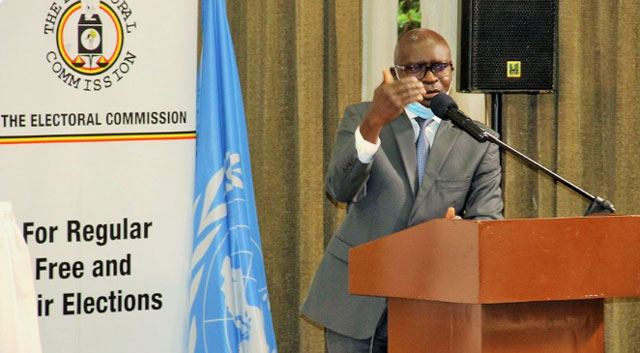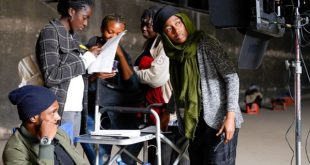
According to experts, the High Court could fail to beat the election deadline. That is the crisis Byabakama risks causing. How he handles the issues of Bobi Wine and NUP might lead to a postponement of the election beyond February 2021. Is that Byabakama’s objective?
Byabakama’s hand tied?
The other is a contest over the red colour between NUP and the Uganda Peoples Congress (UPC).
Byabakama says NUP registered a white umbrella with a blue background as its symbol. The implication is that white and blue are the colours of NUP. Byabakama says the Commission refused a request by NUP to change its colours to include red “because red had already been gazetted for UPC”.
But NUP says their umbrella symbol has red alongside, navy blue and white. They have vowed any aggrieved party to sue NUP in court. The UPC has said it is not going to court over the colour. But it wants the EC to block NUP. Can Byabakama lawfully do that?
The law gives the EC power to allocate party colours. According to Section 8(a) of the Political Party and other Organizations Act, a political party or organisation shall not submit to the Electoral Commission for registration, any identifying symbol, slogan, colour or name which is the same as or similar to the symbol slogan, colour or initial of any registered political party or organisation.
This has been a big debate in the media and the dominant view is that Byabakama is right; the red colour has historically been associated with UPC. Recently, Bobi Wine popularised red as the colour of the People Power movement that propelled him to prominence. People Power supporters have been decked in red shirts and jackets, scarves, and berets.
Any initial attempt by the government to limit People Power’s use of red berets, claiming the red berets are a registered uniform of the Uganda armed forces, appears to have failed.
It is unclear how much success Byabakama will have in blocking the NUP from using red as its party colour. Byabakama can of course invoke his powers to deregister NUP for infringing on the colours of another party.
Article 21 of the Political Parties and Organisations Act, 2005 which deals with non-compliance with the electoral laws says the Commission cannot unilaterally deregister NUP. It must take the matter to the High Court.
According to legal commentators, Byabakama has not taken NUP to court because he is not assured of success of his petition. It might turn out to be a time wasting expedition with negligible benefits even when successful.
In any case, according to many commentators, fighting over party colours is diversionary. Some political parties choose colours as ideology indicator and not as brand signatures. This means political parties that share political ideologies may use the same colours, even within the same electoral contexts.
The symbols of the two dominant parties in the U.S.; the republicans and Democrats have three colours; red, blue, and white stars. Red has been associated with the Republicans and blue with Democrats. Those are also the colurs of the U.S. flag. And most American politicians use different combinations of red, blue and white. It happens even within the same party.
EC’s image problem
Makerere University Kampala political science don, Prof. Sabiti Makara , who has observed various EC bosses struggling under such challenging times is of the view that the EC is “struggling with an image problem”.
In a paper titled `The management of the 2011 elections in Uganda’, Makara says the EC has tried to correct its image but political elites and a good number of Ugandans believe that EC is not up to the task because of how it is appointed.
“Under the constitution, the EC is supposed to be non-partisan,” he writes, “However, the main argument is that the present EC is partisan.”
And he warns that the behavior of the EC can lead to national disaster.
“Good election practices can reduce cases of violence and instability,” he says, “Flawed elections on the other hand can be a recipe for disaster.”
He says Uganda’s 1980 elections are a classic case of what can happen when elections go wrong. He says the elections were manipulated in favour of Uganda Peoples Congress (UPC),to the disadvantages of the Democratic Party (DP).
“As a result, DP supporters mainly in Buganda supported the rebellion (by Museveni) against the UPC government,” Makara says. He adds: “Though the general convention is that taking arms against an elected government is not accepted, the rebel forces of the National Resistance Army/Movement (NRA/NRM) had a popular base within Buganda region’s cheated and disgruntled population.”
Makara says at the centre of the electoral fraud in the 1980 elections was a discredited Electoral Commission headed by S. M. Kikira, a diehard member of UPC party who took orders from the then de facto president, Paulo Muwanga, another UPC stalwart bent on returning Obote to power.
Makara then shifts to the present and argues that the Electoral Commission of 2011 lacked the necessary autonomy from the incumbent President, and that its Chairperson, Badru Kiggundu and his Secretary are ardent supporters of the NRM. He says both of them were active political actors in the Movement before their appointment to the Electoral Commission. Based on such observations, Byabakama must now ponder over what will be written about him after the 2021 election.
 The Independent Uganda: You get the Truth we Pay the Price
The Independent Uganda: You get the Truth we Pay the Price



The decision to let Besigye run for president was a blessing in disguise for the incumbent – a tactical showo of democracy and a wise move for the incumbent but blindfolding to naive people who thought it was not stage managed.